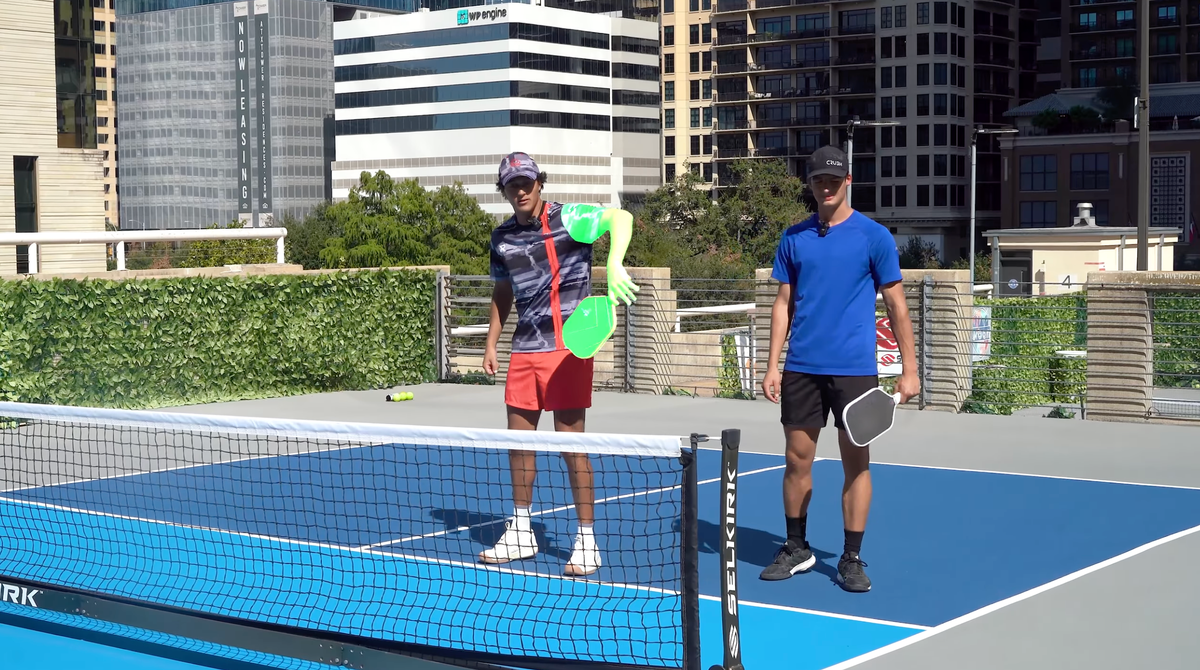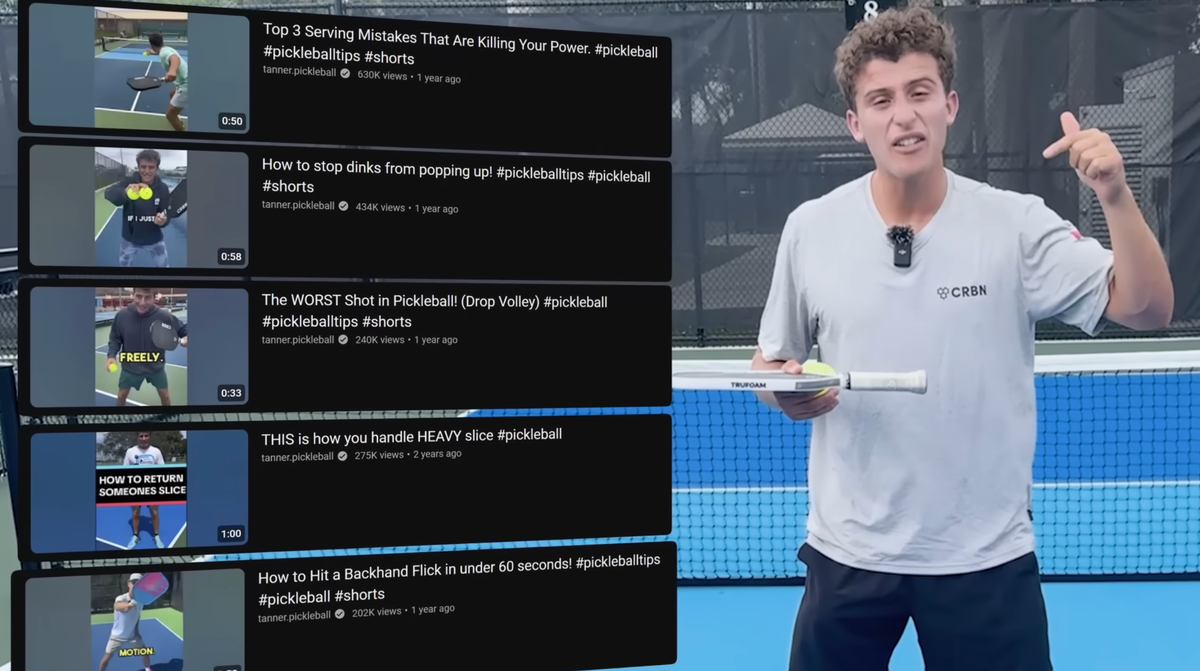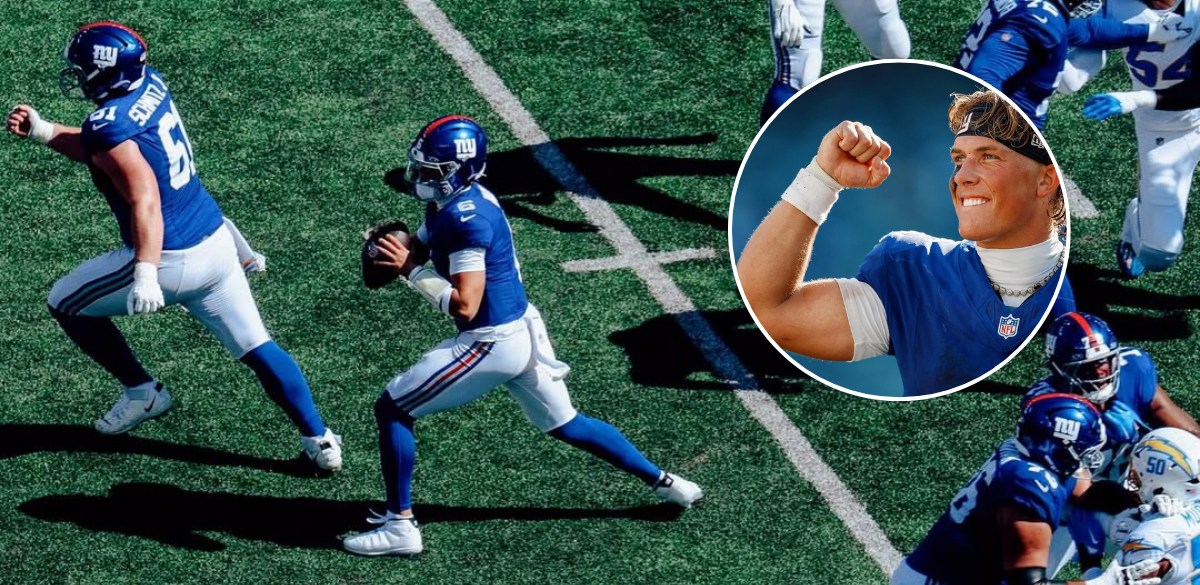The ability to handle pace and redirect power from the kitchen line is what separates competitive players from recreational wannabes.
Your volleys are costing you matches. Not because you lack talent or practice time, but because you're making the same fundamental mistakes that plague thousands of recreational players across the country.
Jordan Briones from Briones Pickleball Academy just dropped an in-depth tutorial on the counter volley. Straight up: it's the kind of content that separates players who plateau at 3.5 from those who push through to 4.0 and beyond.
Love pickleball? Then you'll love our free newsletter. We send the latest news, tips, and highlights for free each week.
The counter volley might be the most underrated shot in pickleball.
While everyone obsesses over the perfect dink or that Instagram-worthy Erne, the ability to handle pace and redirect power separates competitive players from recreational ones. Briones breaks down six mistakes that are sabotaging your counter game, and the fixes are simpler than you think.
The Paddle Face Problem That's Sending Your Balls Into the Net
Paddle angles are everything, and most players get them completely wrong.
When you're facing a speed-up or drive above the net, your natural instinct might be to close your paddle face downward. Maybe you're in a continental grip and rotating your wrist inward, or perhaps you've shifted to an eastern backhand grip. Either way, if your paddle face is angled down at contact, physics isn't on your side.
"When I contact the ball out in front in a good zone, but my paddle angle is face down, it can't clear the net," Briones explains.The fix? Keep that paddle face slightly open at contact. It sounds counterintuitive when you're trying to keep the ball low, but that slight opening is what allows you to clear the net while maintaining control.
Stop Reaching Like You're Trying to Catch a Bus
The second mistake is all about contact point, and it's costing you power. Players prep early for drives and speed-ups (which is good), but then they make contact way too far in front of their body.
When your elbow is fully extended and you're leaning forward like you're reaching for something just out of grasp, you've already lost the point.
From that overextended position, your paddle face naturally opens upward, and you have zero room to push through the shot. You're essentially hitting with just your arm, no body weight, no shoulder rotation, nothing.
How Sitting Neutral Can Transform Your Counters and Chop the Chicken Wing for Good
Instead of committing to one side, tuck your elbow and stay balanced in the middle. This way you can react to where the ball actually goes.
 The Dink PickleballAlex E. Weaver
The Dink PickleballAlex E. Weaver

Instead, wait for the ball to come into your optimal impact zone, roughly one to one-and-a-half paddle lengths in front of you. From this position, you maintain balance, control your paddle angle, and can actually drive through the shot with your shoulder.
It's the difference between swatting at the ball and striking through it.
The Downward Swing Trap
You know what kills more counter volleys than anything else? Swinging downward. It makes sense in theory: you want to keep the ball low, attack your opponent's feet, maybe force a pop-up. But when you prep high and finish low, especially on balls at waist level, you're sending that ball straight into the net.
The fix requires a complete mental shift: push out toward your target using your shoulder. Think linear swing path, not downward trajectory.
This is particularly critical for balls at waist level. High balls? Sure, you might get away with a slight downward angle. But developing the habit of pushing out toward your target, regardless of ball height, creates consistency. And consistency wins matches.
💡
Heads up: hundreds of thousands of pickleballers read our free newsletter. Subscribe here for cutting edge strategy, insider news, pro analysis, the latest product innovations and more.
Your Ready Position Is Sabotaging Your Reaction Time
Here's a misconception that plagues intermediate players: holding your paddle way out in front of your body means you're ready for anything. Wrong.
When your paddle is fully extended in front of you and a ball comes screaming at your chest, you have nowhere to go.
- You can't generate power
- You can't push through
- You end up either using all wrist
Briones demonstrates both scenarios, and the difference is stark. With an overextended ready position, he's forced to use wrist flicks or make a two-part motion. Neither works when you're dealing with pace.
The solution is counterintuitive: relax.
Hold your paddle in a more relaxed position, closer to your body. Keep your arm and elbow loose. From this position, when you see the attack coming, you can push out toward the ball with your full shoulder rotation and body weight behind it.
The 4th Shot Mindset: Stop Inviting Your Opponents to the Kitchen Line
Stop playing the fourth shot like it’s a formality. Instead, recognize it for what it is: your last chance to apply pressure before your opponent gets a chance to attack.
 The Dink PickleballThe Dink Media Team
The Dink PickleballThe Dink Media Team

The Elbow Hinge That's Destroying Your Power (and Your Joints)
Common mistake number five is all about where your power originates. If you're hinging your volley from your elbow, you're making two critical errors.
- First, you're putting unnecessary strain on your elbow joint (hello, pickleball elbow).
- Second, you're generating power from a small, relatively weak muscle group instead of your shoulder.
Your shoulder is a significantly larger and stronger muscle than your forearm. When you hinge from the elbow, you're essentially hitting with just your forearm. When you push from the shoulder, you're engaging your entire upper body.
This technical adjustment not only increases your power and consistency but also helps prevent injury. Pickleball elbow is real, and it's often caused by overusing smaller muscle groups to generate power that should come from larger ones.
The Weight Transfer Problem Nobody Talks About
The sixth and perhaps most common mistake Briones sees on court? Players backing up or lifting their body weight when receiving pace. When you're falling backward or rising up on your toes as you make contact, your weight is moving away from your target. The result? Weak counters that float up and give your opponent another opportunity to attack.
"If I'm falling back at all, I don't have my weight moving forward, and I'm not going to be able to get a really strong counter," Briones notes. The physics are simple: weight moving backward equals ball going up with minimal pace.
A Pro Coach Distilled a Year’s Worth of Tips into One 7-Step Masterclass
These aren’t exotic shots or niche strategies. These are the bread-and-butter techniques that separate players who plateau from players who keep climbing.
 The Dink PickleballThe Dink Media Team
The Dink PickleballThe Dink Media Team

Instead, keep your weight on the balls of your feet right before contact. Make sure your chest is over your knees. This ensures you're leaning into the shot, not away from it. You don't need a massive swing when your body weight is moving forward. The momentum does half the work for you.
Putting It All Together
The counter volley isn't just about reacting to pace. It's about positioning your body correctly, using the right muscle groups, maintaining proper paddle angles, and transferring your weight effectively.
These six mistakes (closed paddle face, overextended contact point, downward swing path, overextended ready position, elbow hinging, and backward weight transfer) are interconnected.
Fix one, and you'll likely see improvement. Fix all six, and you'll transform your ability to handle bangers and aggressive players – and dominate the kitchen line in the process.
The counter is a defensive shot that can quickly become offensive when executed properly. It's how you turn your opponent's power against them.
Anuncie Aqui / Advertise Here
Sua marca para o mundo Pickleball! / Your brand for the Pickleball world!

 English
English  Spanish
Spanish  Portuguese
Portuguese  German
German  Italian
Italian  Japanese
Japanese  French
French  Polish
Polish  Russian
Russian  Netherlands
Netherlands  Hungarian
Hungarian  Turkish
Turkish  Videos
Videos 








 English (US) ·
English (US) ·  Portuguese (BR) ·
Portuguese (BR) ·